Related Research Articles

Villa Savoye is a modernist villa and gatelodge in Poissy, on the outskirts of Paris, France. It was designed by the Swiss-French architect Le Corbusier and his cousin Pierre Jeanneret, and built between 1928 and 1931 using reinforced concrete.

Ricardo Bofill Leví was a Spanish architect from Barcelona, Spain. He founded Ricardo Bofill Taller de Arquitectura in 1963 and developed it into a leading international architectural and urban design practice. According to architectural historian Andrew Ayers, his creations rank "among the most impressive buildings of the 20th century."

The International Style is a major architectural style and movement that began in western Europe in the 1920s and dominated modern architecture until the 1970s. It is defined by strict adherence to functional and utilitarian designs and construction methods, typically expressed through minimalism. The style is characterized by modular and rectilinear forms, flat surfaces devoid of ornamentation and decoration, open and airy interiors that blend with the exterior, and the use of glass, steel, and concrete.

Peter David Eisenman is an American architect, writer, and professor. Considered one of the New York Five, Eisenman is known for his high modernist and deconstructive designs, as well as for his authorship of several architectural books. His work has won him several awards, including the Wolf Prize in Arts.

Josep Lluís Sert i López was a Catalan architect and city planner established in the USA after 1939.
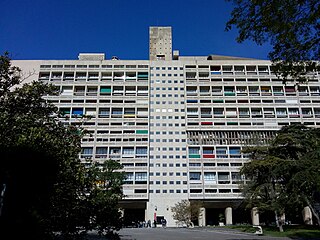
The Unité d'habitation is a modernist residential housing typology developed by Le Corbusier, with the collaboration of painter-architect Nadir Afonso. It formed the basis of several housing developments throughout Europe designed by Le Corbusier and sharing the same name.

Postmodern architecture is a style or movement which emerged in the 1960s as a reaction against the austerity, formality, and lack of variety of modern architecture, particularly in the international style advocated by Philip Johnson and Henry-Russell Hitchcock. The movement was formally introduced by the architect and urban planner Denise Scott Brown and architectural theorist Robert Venturi in their 1972 book Learning from Las Vegas. The style flourished from the 1980s through the 1990s, particularly in the work of Scott Brown & Venturi, Philip Johnson, Charles Moore and Michael Graves. In the late 1990s, it divided into a multitude of new tendencies, including high-tech architecture, neo-futurism, new classical architecture, and deconstructivism. However, some buildings built after this period are still considered postmodern.

Sainte Marie de La Tourette is a Dominican Order priory, located on a hillside near Lyon, France, designed by the architect Le Corbusier, the architect’s final building. The design of the building began in May 1953 and completed in 1961. The committee that decided the creation of the building considered that the primary duty of the monastery should be the spiritual awakening of the people and in particular the inhabitants of nearby areas. As a result, the monastery was constructed in Eveux-sur-Arbresle, which is just 25 km from Lyon and is accessible by train or car.

Balkrishna Vithaldas Doshi OAL was an Indian architect. He is an important figure in Indian architecture and noted for his contributions to the evolution of architectural discourse in India. Having worked under Le Corbusier and Louis Kahn, he was a pioneer of modernist and brutalist architecture in India.

Henry Dermot Ponsonby Moore, 12th Earl of Drogheda, is a British photographer known professionally as Derry Moore. He inherited the title of Earl of Drogheda from his father, The 11th Earl of Drogheda. He had the right to use the courtesy title Viscount Moore from November 1957 until December 1989.

Jan Dibbets is an Amsterdam-based Dutch conceptual artist. His work is influenced by mathematics and works mainly with photography.
Othmar Schimkowitz was a Hungarian-born architectural sculptor who worked on the greatest landmarks of the Vienna Secession.
L'Architecture Vivante was a French language quarterly magazine for avant-garde architecture published in France from 1923 to 1932.

Ville radieuse was an unrealised urban design project designed by the French-Swiss architect Le Corbusier in 1930. It constitutes one of the most influential and controversial urban design doctrines of European modernism.
Nikos Economopoulos is a Greek photographer known for his photography of the Balkans and of Greece in particular.
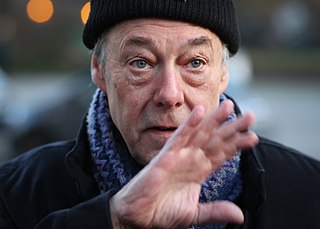
Gerald David "Gerry" Badger is an English writer and curator of photography, and a photographer.
Alistair John Rowan is an Irish architectural historian, a retired university teacher, a building conservationist and an author of British, Irish and Italian architectural history.
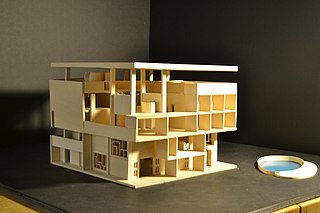
Villa Shodhan is a modernist villa located in Ahmedabad, India. Designed by the Swiss architect Le Corbusier, it was built between 1951 and 1956. Building on his previous projects whilst integrating the traditional features of Ahmedabad design, the villa symbolizes Le Corbusier's domestic architecture. The building is currently used as a private residence.
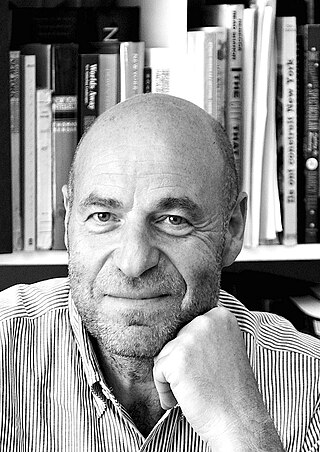
Jean-Louis Cohen was a French architect and architectural historian specializing in modern architecture and city planning. Since 1994 he had been the Sheldon H. Solow Professor in the History of Architecture at New York University Institute of Fine Arts.
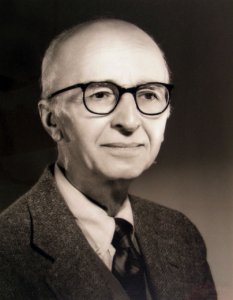
Jean Victor Edmond Paul Marie Bony was a French medieval architectural historian specialising in Gothic architecture. He was Slade Professor of Fine Art at the University of Cambridge from 1958 to 1961, Fellow of St John's College, Cambridge, and Professor of Art at the University of California at Berkeley, from 1962 to 1980.
References
- 1 2 3 "William Curtis, 17.04.2019 – Architecture Alive". www.architecture-alive.com. Retrieved 18 January 2022.
- ↑ Gapp, Paul (2 April 1987). "IDEAS, HISTORY, EVEN PORNOGRAPHY FILL NEW BOOKS ON ARCHITECTURE". Chicago Tribune . p. 9. Archived from the original on 6 November 2012. Retrieved 5 June 2011.
- 1 2 Gewertz, Ken (24 July 2004). "Late bloomer". Harvard Gazette. Retrieved 5 June 2011.
- ↑ Curtis, William J. R. (3 May 2012). "William J.R Curtis". www.hoart.cam.ac.uk. Retrieved 18 January 2022.
- ↑ Curtis, William J. R. (1996). Modern architecture since 1900 (3rd ed., [rev., expanded, and redesigned] ed.). [London]: Phaidon. p. 131. ISBN 0-7148-3524-2. OCLC 35335295.
- ↑ "The Alice Davis Hitchcock Medallion" (PDF). Architectural History Journal of the Society of Architectural Historians of great Britain. 29 : 1986.
- ↑ "William JR Curtis". The Indian Express. 2 January 2021. Retrieved 18 January 2022.
- ↑ Sugar & Spice (25 July 2019). "William J.R. Curtis". CICA Architecture (in Spanish). Retrieved 18 January 2022.
- ↑ "Structures of Light – Photographs by William J. R. Curtis". bookm-ark.fi. Retrieved 18 January 2022.
- ↑ "Who made the Conway Library?". Digital Media. 30 June 2020. Retrieved 18 January 2022.
- ↑ 361 degrees (2014) William J R Curtis, Architecture Critic, France